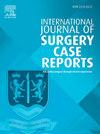Colic ameboma mimicking colic cancer: A case report
IF 0.6
Q4 SURGERY
引用次数: 0
Abstract
Introduction
Amoebic colitis, caused by the protozoan Entamoeba histolytica, is a significant global health concern, ranking as the second leading cause of parasitic infection-related mortality. The disease manifests across a wide clinical spectrum, from asymptomatic carriers to severe necrotizing colitis. Rarely, it can form an inflammatory mass, or ameboma, which may mimic malignancy.
Case presentation
We report a case of a 60-year-old female presenting with acute right iliac pain, fever, and nausea, but no diarrhea or recent travel history. Imaging revealed irregular cecal thickening with features suggestive of a perilesional abscess. Exploratory laparotomy identified a 7 cm cecal mass with necrotic tissue, leading to a right hemicolectomy. Histopathology confirmed amoebic colitis with trophozoites in necrotic areas. Postoperative recovery was uneventful with antibiotic therapy.
Discussion
Ameboma, an uncommon complication of amoebic colitis, poses diagnostic challenges due to its tumor-like appearance. Misdiagnosis is common, especially in non-endemic regions, where clinical and radiological findings often mimic malignancy. Diagnosis requires a combination of serology, stool examination, and biopsy. Treatment is primarily medical, with surgical intervention reserved for complications. Preventive strategies, including sanitation improvements and vaccine development, are crucial to reducing disease burden.
Conclusion
This case underscores the importance of considering amoebiasis in differential diagnoses, even in non-endemic regions. Enhanced diagnostic awareness and preventive measures can significantly improve outcomes and reduce the global health impact of amoebiasis.
求助全文
约1分钟内获得全文
求助全文
来源期刊
CiteScore
1.10
自引率
0.00%
发文量
1116
审稿时长
46 days

 求助内容:
求助内容: 应助结果提醒方式:
应助结果提醒方式:


